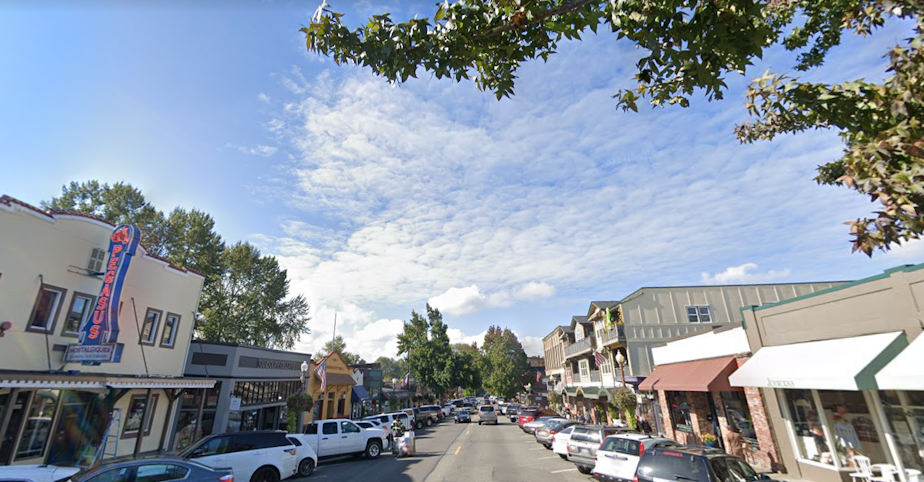The right-wing occupation of this tiny Washington town, and the surprising aftermath

On May 31, 2020, Wil Johnson turned on his TV to watch the news. At the time, protestors across the country were coming together against police brutality and racism following the murder of George Floyd.
But what Johnson saw next startled him.
After news of protests and demonstrations in Bellevue, the coverage flipped to a small town.
“I saw a truck with a Confederate flag, and I saw rifles,” Johnson said.
He didn't realize it at first, but it soon became clear that Johnson was watching was the occupation of First Street in downtown Snohomish, Washington.
A day before, community members in Snohomish gathered for their own protests for Black Lives Matter and George Floyd. But a tweet from a supposed Antifa group, sent out earlier that afternoon, prompted another group to come to Snohomish.
Soon, armed individuals, including a member of the far-right group the Proud Boys, descended on Snohomish’s First Street. Several people standing outside businesses were also drinking alcohol and carrying assault weapons.
Sponsored
“What went through my mind was, ‘Oh, I guess I don’t belong in Snohomish, and I won’t be going there anytime soon,” Johnson said.
But Johnson did end up in Snohomish. The Snohomish School District hired Johnson in July 2021 to be its first director of equity and inclusion.
Pushback
Johnson says that even before he was hired by the district, there were teachers that were pushing to build a framework around equity and inclusion. But that doesn’t mean his arrival didn’t trigger pushback from the community. That was evident at one school board meeting he attended where protestors showed up.
“My introduction to the district was quite a few people outside with signs concerned about whether it was [critical race theory], equity in general,” Johnson said. “Like, ‘Why are we creating this position?’ and comments were made that to talk about race is to be divisive or racist.”
Sponsored
Wil now works directly with teachers and other district staff through trainings on diversity and equity. Based on the work he’s done with teachers, students and other members of the community, he feels Snohomish is capable of making the work around equity a sustainable effort.
“What Happened on First Street”
Other community members have found a creative approach to understanding and analyzing May 31, 2020.
What happened on May 31 inspired two Snohomish residents, Drake Wilson and Carolyn Yip, to collect clips from social media related to that day, and interview fellow Snohomians.
The result is the documentary What Happened on First Street which follows not only what happened on that Sunday afternoon in May 2020, but also provides a platform for community members of color to share their experience of what it’s like to live and work in this mostly white city.
Sponsored
Yip and Wilson worried that if they didn’t do something to record what happened that day, it would get swept under the rug or forgotten — dismissed as an isolated incident.
“We wanted to see if we could dig a little deeper,” Yip said. “And persuade people as to like, this is not just an isolated incident — there’s other actions that we need to do, and work together as a community to try and make sure this doesn’t happen again.”
To dig beyond the surface of May 31, 2020, the documentarians put the lived experiences of community members of color at the center of their project — something Wilson and Yip say had never really been done before in Snohomish.
“I know even for myself, being a person of color very much informed by experience and did make it difficult to sometimes feel fully connected and seen in Snohomish,” Wilson said.
One of the voices featured in the documentary is Kathy Purviance Snow, a teacher at Snohomish High School.
Sponsored
“I’ve had students put the N-word on papers. Microaggressions like wanting to touch my hair,” Purviance Snow said. “It’s very disconcerting to have someone stare at you angrily, as if ‘Why are you here? What are you doing in my town?’ when it’s my town too.”
Other people talked about how, based on their experience in the Snohomish School District, they felt that the school curriculum failed to reflect the experiences and perspectives of people of color.
“There are perspectives I missed out on completely growing up K-12 in this area," said Kevin Tshilombo, a 2016 graduate of Glacier Peak High School.
“When I entered college, I was a part of the Black Student Union and went to different cultural clubs. I was like ‘Wow, this happened in the United States?"
After May 31, 2020, a local group of educators brought a list of demands created by a group of Snohomish youth called Gen J to the district.
Sponsored
Some demands, like trainings focused on equity and inclusion to staff, have been implemented. But others, like updating curriculum, are in the works.
After watching armed vigilantes occupy First Street, Drake Wilson told himself he would never be able to look at this piece of his hometown the same way again. But he says working on the documentary has been healing, and now, he’s choosing to focus on how to make his hometown a better place for everyone.
“Snohomish is my home, and I love Snohomish so much, and my family has been here for so long,” Wilson said. “I’m not going anywhere. This is always going to be my hometown and I really do love it.”
The next screening of What Happened on First Street is planned for January 17. You can register for the virtual event on Eventbrite.




